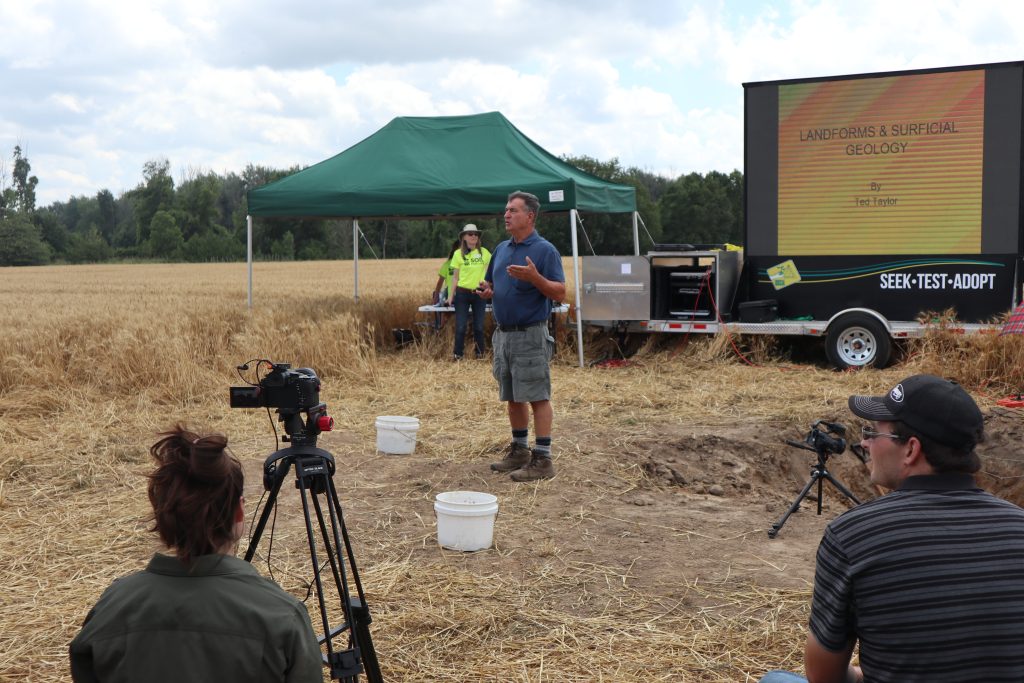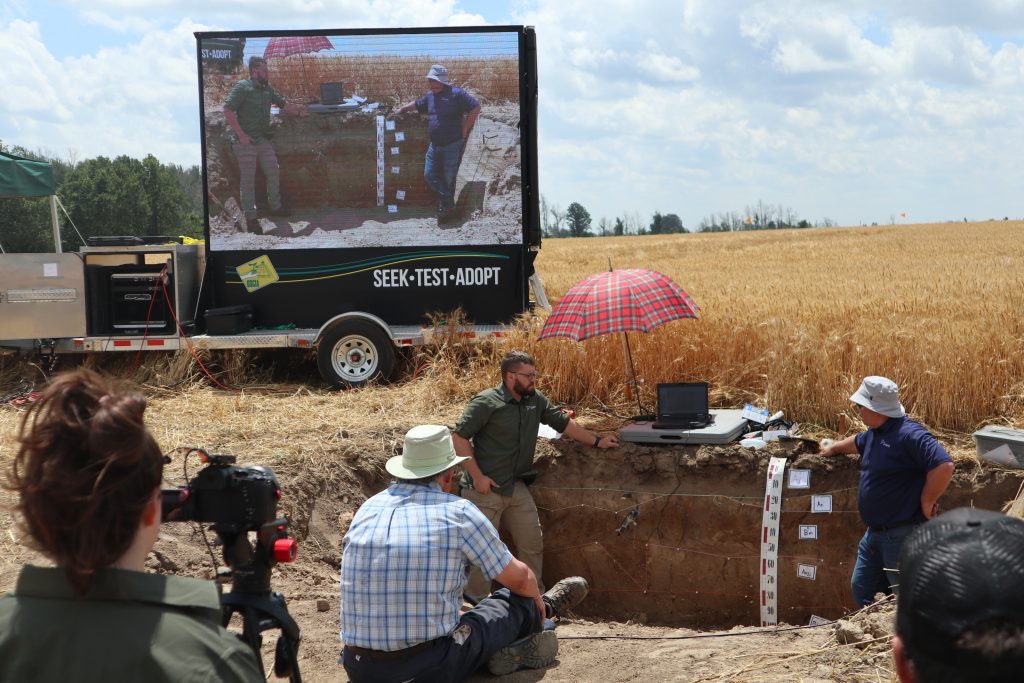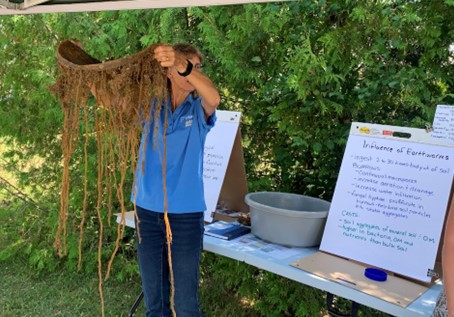Back to Innovator ~~~ Next article ~~~ Previous article
By Sarah Fox, OSCIA Soil Health Intern
The power of soil health was on full display at the Grand River Raceway, July 21, 2022, through a series of engaging hands-on demonstrations that explored different aspects of soil health. Led by OMAFRA’s soil team, five different stations offered insight as to how cropping systems and field management decisions can impact the soil’s ability to thrive.
Kevin McKague, Water Quality Engineer, demonstrated how soil organic matter, drainage and compaction impact the soil’s ability to hold onto water. Using the Guelph Permeameter, an instrument that measures the soil’s hydraulic conductivity (i.e., ability of water to pass through soil), participants were able to observe how water permeation is impacted by variations in soil conditions.
The capacity for water to move through and be retained by soil depends on several factors, including texture and mineral composition of the soil; density or compaction of the soil; and soil organic matter. Farmers can improve drought resilience by implementing practices to increase soil organic matter and reduce compaction, such as the addition of high-residue, deeply rooted cover crops.
The rainfall simulator station similarly demonstrated the importance of maintaining soil organic matter and reducing compaction to better absorb water, as well as reduce surface runoff and erosion. Water absorption and surface runoff were tested on four soil samples from different fields with varying levels of organic matter, tillage, and crop type. The rainfall simulator consistently showed that the greatest surface erosion and poorest water retention occurred in tilled soils with low organic matter content.

Live from the soil pit with the MSTS LED screen, Ted Taylor provides an opportunity to view various soil structures up-close.
The MSTS LED screen provided attendees with an up-close-and-personal look into the soil. Ted Taylor, Soil Resource Specialist with SRG, explained how the surficial geology and glacial formation influences the landforms and soil that we have today. Jim Warren, Land Resource Specialist and Alex Barrie, Soil Management Engineer, explained how a soil’s geological history, heavy equipment traffic, and crop management can impact the structure of the soil and the formation of the soil horizons. Jim explained the impact that prior tillage in a field may have had on the soils “A” horizon (topsoil). As topsoil is tilled, it can mix with the low-nutrient layers below, ultimately diluting the nutrient-rich topsoil. Furthermore, as layers from the lower “B” horizon are mixed into the topsoil, through tillage, the iron-rich “B” horizon soil will interact with the phosphorous (P) in the topsoil, depleting P available for crops.

Live from the soil pit with the MSTS LED screen, OMAFRA’s Soil Team members Alex and Jim discuss the impact heavy equipment has on soil compaction.
Did you know that one tablespoon of healthy soil contains more than one billion microbes? Jake Munroe, Soil Management Specialist, demonstrated the integral role that bugs, bacteria, fungi, and all other microscopic organisms play in helping to cycle carbon and maintain soil health. A Solvita ® test (an in-situ test that measures soil respiration) was done to compare the CO2 levels between two soil samples with different levels of disturbance (due to tillage), and organic matter. The soil with less disturbance and higher organic matter yielded greater CO2 levels, as CO2 output is directly related to microbial activity. Additionally, several pairs of “soiled undies” (100% cotton underwear buried in the soil) from different fields were on display. Similar to the Solvita ® test, it was clear to see that the soiled undies from fields with less disturbance and more organic matter were more significantly decomposed due to greater microbial activity. Managing soil health by minimizing mechanical disturbances, such as tillage, and increasing soil organic matter are essential for ensuring a healthy, robust, and productive soil microbiome.
The small but mighty earthworm plays an important role in helping maintain soil health. Christine Brown, Field Crops Sustainability Specialist, used various visual aids, such as a resin casting of worm burrows, showing how effective earthworms are at helping to maintain soil structure. Earthworms are excellent soil engineers, burrowing through the soil to increase porosity and water infiltration. They feed on decomposed plant material and microorganisms in the soil which, once digested, makes essential nutrients available for plant uptake. Like soil microbes, no-till and other conservation practices that help to increase soil organic matter create the ideal habitat for earthworms to live, burrow, and cycle nutrients.
Field days such as these, are invaluable for exchanging ideas, learning from experts, and catching up with neighbours near and far. The event at Grand River Raceway provided attendees with a lot of information on soil health and ways to improve soil productivity Information on upcoming SCIA events across the province are posted on our website: www.ontariosoilcrop.org/upcoming-events/.
Back to Innovator ~~~ Next article ~~~ Previous article
